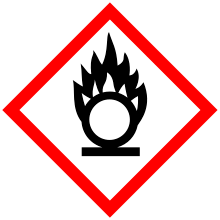Iron(III) nitrate
 | |
| Names | |
|---|---|
| IUPAC name
Iron(III) nitrate | |
| Other names
Ferric nitrate Nitric acid, iron(3+) salt | |
| Identifiers | |
| |
3D model (JSmol) |
|
| ChemSpider | |
| ECHA InfoCard | 100.030.805 |
PubChem CID |
|
| RTECS number | NO7175000 |
| UNII | |
| |
| |
| Properties | |
| Fe(NO3)3 | |
| Molar mass | 403.999 g/mol (nonahydrate) 241.86 g/mol (anhydrous) |
| Appearance | Pale violet crystals hygroscopic |
| Density | 1.68 g/cm3 (hexahydrate) 1.6429 g/cm3(nonahydrate) |
| Melting point | 47.2 °C (117.0 °F; 320.3 K) (nonahydrate) |
| Boiling point | 125 °C (257 °F; 398 K) (nonahydrate) |
| 150 g/100 mL (hexahydrate) | |
| Solubility | soluble in alcohol, acetone |
| +15,200.0·10−6 cm3/mol | |
| Structure | |
| octahedral | |
| Hazards[1] | |
| GHS pictograms |   |
| GHS signal word | WARNING |
| H272, H302, H319 | |
| P210, P220, P221, P264, P270, P280, P301+312, P305+351+338, P330, P337+313, P370+378, P501 | |
| NFPA 704 | |
| Flash point | non-flammable |
| US health exposure limits (NIOSH): | |
REL (Recommended) |
TWA 1 mg/m3[2] |
| Related compounds | |
Related compounds |
Iron(III) chloride Iron(III) sulfate |
Except where otherwise noted, data are given for materials in their standard state (at 25 °C [77 °F], 100 kPa). | |
| Infobox references | |
Iron(III) nitrate, or ferric nitrate, is the chemical compound with the formula Fe(NO3)3. Since it is deliquescent, it is commonly found in its nonahydrate form Fe(NO3)3·9H2O in which it forms colourless to pale violet crystals. When dissolved, it forms yellow solution due to hydrolysis.
Preparation
The compound is prepared by treating iron metal powder with nitric acid.
- Fe + 4 HNO3 → Fe(NO3)3 + NO + 2 H2O.
Applications
In the chemical laboratory
Ferric nitrate is the catalyst of choice for the synthesis of sodium amide from a solution of sodium in ammonia:[3]
- 2 NH3 + 2 Na → 2 NaNH2 + H2
Certain clays impregnated with ferric nitrate have been shown to be useful oxidants in organic synthesis. For example, ferric nitrate on Montmorillonite—a reagent called "Clayfen"—has been employed for the oxidation of alcohols to aldehydes and thiols to disulfides.[4]
Other applications
Ferric nitrate solutions are used by jewelers and metalsmiths to etch silver and silver alloys.
References
- ↑ HSNO Chemical Classification Information Database, New Zealand Environmental Risk Management Authority, retrieved 2010-09-19 .
- ↑ "NIOSH Pocket Guide to Chemical Hazards #0346". National Institute for Occupational Safety and Health (NIOSH).
- ↑ Hampton, K. G. Harris, T. M.; Hauser, C. R. (1973). "2,4-Nonanedione". Organic Syntheses. ; Collective Volume, 5, p. 848 As of 2007, 22 other entries describe similar preparations in Organic Syntheses
- ↑ Cornélis, A. Laszlo, P.; Zettler, M. W. "Iron(III) Nitrate–K10 Montmorillonite Clay" in Encyclopedia of Reagents for Organic Synthesis (Ed: L. Paquette) 2004, J. Wiley & Sons, New York. doi:10.1002/047084289.
Salts and covalent derivatives of the nitrate ion | |||||||||||||||||||
|---|---|---|---|---|---|---|---|---|---|---|---|---|---|---|---|---|---|---|---|
| HNO3 | He | ||||||||||||||||||
| LiNO3 | Be(NO3)2 | B(NO 3)− 4 |
C | NO− 3, NH4NO3 |
O | FNO3 | Ne | ||||||||||||
| NaNO3 | Mg(NO3)2 | Al(NO3)3 | Si | P | S | ClONO2 | Ar | ||||||||||||
| KNO3 | Ca(NO3)2 | Sc(NO3)3 | Ti(NO3)4 | VO(NO3)3 | Cr(NO3)3 | Mn(NO3)2 | Fe(NO3)3, Fe(NO3)2 |
Co(NO3)2, Co(NO3)3 |
Ni(NO3)2 | Cu(NO3)2 | Zn(NO3)2 | Ga(NO3)3 | Ge | As | Se | Br | Kr | ||
| RbNO3 | Sr(NO3)2 | Y | Zr(NO3)4 | Nb | Mo | Tc | Ru | Rh | Pd(NO3)2 | AgNO3 | Cd(NO3)2 | In | Sn | Sb(NO3)3 | Te | I | Xe(NO3)2 | ||
| CsNO3 | Ba(NO3)2 | Hf | Ta | W | Re | Os | Ir | Pt | Au | Hg2(NO3)2, Hg(NO3)2 |
Tl(NO3)3, TlNO3 |
Pb(NO3)2 | Bi(NO3)3 BiO(NO3) |
Po | At | Rn | |||
| FrNO3 | Ra(NO3)2 | Rf | Db | Sg | Bh | Hs | Mt | Ds | Rg | Cn | Nh | Fl | Mc | Lv | Ts | Og | |||
| ↓ | |||||||||||||||||||
| La(NO3)3 | Ce(NO3)3, Ce(NO3)4 |
Pr | Nd | Pm | Sm | Eu(NO3)3 | Gd(NO3)3 | Tb | Dy | Ho | Er | Tm | Yb | Lu | |||||
| Ac(NO3)3 | Th(NO3)4 | Pa | UO2(NO3)2 | Np | Pu | Am | Cm | Bk | Cf | Es | Fm | Md | No | Lr | |||||
